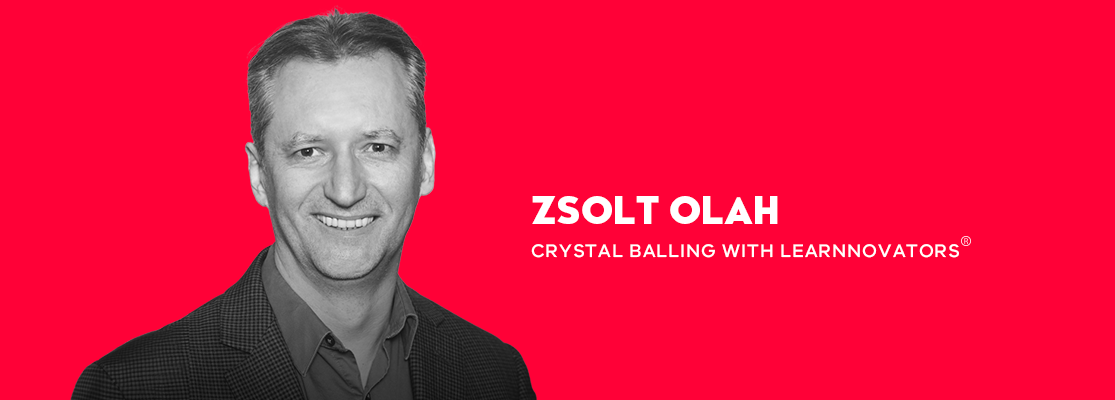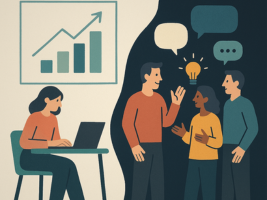ZSOLT OLAH – CRYSTAL BALLING WITH LEARNNOVATORS
ABOUT ZSOLT OLAH:
Zsolt is Sr. HR Data Measurement Analyst at Intel focusing on actionable learning analytics to provide valuable insights to stakeholders. Previously, he worked as a Sr. Learning Technologist at Amazon where he was responsible for the data analytics and the complete learning stack.
Zsolt is a firm believer of the idea that the ultimate goal of workplace learning is not learning but the application and impact on the job. Empowering employees to be able to do their jobs better, faster, and easier, or grow their skills to achieve career goals is what learning should support. This effort requires behavior change. Hence, Zsolt has also been a big proponent of integrating motivational theories (including gamification done right) in learning design.
Zsolt has 20+ years of corporate L&D experience at the intersection of technology, digital learning, and data. He’s a frequent national and international speaker, published author, and featured writer at elearningindustry.com. Zsolt also serves as an advisory board member on the Emerge Workforce Development Edtech Leadership Board chaired by Donald H. Taylor. In his free time, Zsolt has written two screenplays and played mediocre soccer.
ABOUT THIS INTERVIEW SERIES:
Crystal Balling with Learnnovators is a thought-provoking interview series that attempts to gaze into the future of e-learning. It comprises stimulating discussions with industry experts and product evangelists on emerging trends in the learning landscape.
Join us on this exciting journey as we engage with thought leaders and learning innovators to see what the future of our industry looks like.
THE INTERVIEW:
LEARNNOVATORS: Zsolt, we are tremendous fans of your work in the field of digital learning, particularly your innovative use of technology to not only engage learners but also to measure their success effectively. As a pioneer in blending gamification and psychological insights into learning environments, you have transformed the way we approach digital learning. Your contributions have truly set a new standard within the industry. It’s an honor to have you here today to delve into the past, present, and future of workplace learning with three questions.
1. LEARNNOVATORS (THE PAST): Zsolt, your extensive experience in the e-learning industry offers a valuable perspective on its evolution, especially concerning learning technologies. You’ve always held the view that ‘Technology shouldn’t define our thinking.’ Looking back, what were some of the major challenges that the industry faced with the early adoption and integration of new technologies into learning environments? Can you discuss how these challenges were addressed over the years? Moreover, what significant technological milestones do you believe have fundamentally shaped the development of digital learning? How have these advancements impacted the industry’s approach to creating effective learning experiences? And finally, how do you view this past? What are your experiences as an active participant in this journey?
ZSOLT OLAH: Thank you for having me! First, I want to clarify the definition and scope of my answers: For me, as a workplace learning professional, learning technology is any technology (digital or not) that can be used at work to enable the most effective conditions for learning. My focus for the last two decades has been helping the workforce grow their skills to get their job done faster, easier, or better. Since the end goal is not learning, I believe learning technology should never drive us through our journey. Why? Because we may get there faster in style, but we’ll have no idea where we are.
I’ve seen technology come and go in the last two decades. Thirty years ago, I walked into my professor’s office and said I wanted to do something nobody was doing for my thesis yet – something that is innovative and combines technology and learning. He gave me an article about artificial neural networks, and I built one from scratch. On a floppy disc!! It took the neural network months to learn how to add two numbers. It was fascinating to explore this new technology, but it had absolutely no practical use. Today, most people don’t even know what a floppy disc is.
A lot happened since, but I’ve seen a pattern in the L&D industry repeatedly: a fascination with shiny new technology. We invented Computer-Based Training (CBT), Web-Based Training (WBT), and even the “Netflix of Learning” to binge-watch OnDemand courses! See the pattern? They’re all harvesting new technology focusing on the same thing: delivery. We invented the Learning Management Systems (LMS) to maintain all the content we delivered. Again, we harnessed the technology to drive, monitor, and report on content consumption. We invented rapid eLearning that democratized and sped up the creation of learning content.
When we realized there was a problem with engagement after all the content we created, we borrowed gamification technology to drive more content consumption. We invented the Learning Experience Platform concept with the promise to cut through the sea of content, leading us to a more personalized learning journey. We had good intentions with implementing competencies along with skills, but we ran into scalability issues.
All these examples from the past revolve around improving and evolving within our swim lane of L&D. Today, we should be careful about approaching AI the same way. We should not make the same mistake of treating it as the new, shiny technology to enhance our profession. The problem is that AI does not stay in swim lanes. It’s like the wind. It doesn’t care about turfs or traditional rules. You either learn to harness it or it’s going to huff-and-puff blow the roof above you.
Imagining the future based on the past only works if the change that is happening is linear or at least gradual. With AI, most of our imagination is about a better present, not a potentially new future yet. We’re all figuring this out. One thing is sure though: the wind of change is here. And it’s blowing off roofs like the big bad wolf.
Throughout this technology-driven journey, we covered a lot of ground and reached far-away places to finally find the answer: 42. Now, it’s time to figure out what our question was exactly. And that brings me to the fundamental challenge we’ve been struggling with for a long time: measuring the impact of learning. We must be asking the right questions!
2. LEARNNOVATORS (THE PRESENT): Zsolt, in today’s digital learning landscape, Generative AI technology is emerging as a pivotal innovation, reshaping how we create and deliver learning content and performance support solutions. Here’s an excerpt from the book ‘Engines of Engagement: A Curious Book About Generative AI’ (by Julian Stodd, Sae Schatz, and Geoff Stead) which highlights the need for reimagining learning frameworks and methodologies in the era of generative AI. “AI neatly replicates many aspects of higher-level human cognition… this introduces considerable uncertainty into the landscape of learning… This new era of learning by, with, and through Generative AI will need new models of pedagogy and scaffolded self-development, new tools for assessment, new competencies to promote, and new methodologies of synthesis and collaboration”. With your extensive experience at the intersection of technology and learning, how do you see Generative AI influencing current learning technologies? What are the primary challenges and opportunities that this technology presents for learning professionals aiming to leverage it effectively in their learning and development strategies? And finally, what are your experiences as an active participant in this journey?
ZSOLT OLAH: I loved the book, by the way! As one of my data heroes, Edward Tuftee said about new and innovative research findings: “Approach them with an open mind, not with an empty head.” What do I mean by that in the context of Gen AI? Curiosity requires an open mind. We need to suspend our disbelief; we need to let some of our assumptions, biases, and fundamental frame of mind about learning go. At the same time, we can’t just abandon learning science and expect AI to solve all our problems. In fact, we need to return to the fundamental problems we’re trying to solve with a new, open mind. All the restrictions we learned to live with must be re-examined: data, scalability, velocity, personalization, performance support, coaching, etc.
Early research shows that learning professionals are using Gen AI to create content faster and speed up the design process to be more efficient. Efficiency is great! But we shouldn’t forget the other side of the coin: effectiveness. Learning is a process that can take employees where they want to be: doing their jobs better, easier, and faster. Everyone is excited about how AI is accelerating skills development in new directions toward their career inspirations. It’s an exciting time to be a learning professional! However, learning for employees is not the same as consuming content. If an AI assistant is ready 24/7 to help answer questions and get things done, nobody will want to log into the LMS to explore more content about doing the same. Gen AI is not another tool in our learning toolkit. It is like the wind. It’s invisible, it’s everywhere, and it can empower or destroy whatever is in its way.
After all these “theoretical” musings, let me be more practical: Gen AI is not an L&D initiative. Inside an organization, it’s showing up where there’s a direct impact on performance and the business. While we’re figuring out how to use it for learning, the best thing we can do is connect with other functions and observe how it is being deployed.
My team and I started with the fundamentals of data literacy. AI is built on data. Without understanding how to speak data, the language of impact, you may rely solely on Gen AI for answers. While it’s good at answering questions, it often assumes that you’re asking the right questions. I strongly believe that asking the right questions is the skill learning professionals should master before harnessing the power of Gen AI.
3. LEARNNOVATORS (THE FUTURE): Zsolt, as we advance further into the realm of digital learning, the potential emergence of General AI (Gen AI) and Artificial General Intelligence (AGI) is stirring significant interest and speculation. In this context, we recall an intriguing question you raised in one of your recent articles: “If the AI-powered digital tools we have today can help us accomplish our tasks effortlessly, do we need to follow the learning paths of the previous generations? Do we need to learn anything at all?” How do you anticipate Gen AI and AGI will redefine the capabilities and methodologies of learning technologies in the near future? What impact might these advanced technologies have on the design and delivery of learning content? Additionally, what proactive steps should learning professionals take now to harness the full potential of Gen AI and AGI in transforming learning practices and outcomes? Lastly, in a future where collaboration with AI is inevitable, what vision do you have for learning designers to maintain their distinctiveness from AI capabilities?
ZSOLT OLAH: If I could predict the future, I would probably buy stocks instead of doing interviews. That said, here are some thoughts on what might come next (or is already here by the time you’re reading this). One of the side effects of ubiquitous AI is destroying silos like huff and puff. Both human and data silos! We are no longer operating in isolated areas such as talent acquisition, onboarding, comms, talent development, leadership development, learning and development, change management, etc. All through the employee lifecycle, at the receiving end of all these services are the same employees. We need to let go of controlling our turf with our cute buildings because the wind doesn’t care about private property signs.
We’ve been talking about learning ecosystems for a while. Cobbling together different disjointed platforms is not an ecosystem. They need to operate together seamlessly. Skills, for example, need to be part of learning, career development, coaching, and performance management—but in context! You don’t just magically acquire a skill by completing a course. Soon, everything you do (online and offline, on any learning platform) will clearly show your progress toward your goal.
I just returned from the Learning Technologies conference in London, and I can tell you that all platforms are now AI-powered. This reminds me of the fundamental skill again that all learning professionals should master: asking the right questions. We need to cut through the shiny object haze.
What’s the role of L&D in this new world? What happens to learning design? I think we don’t design learning. Learning happens. We don’t have control over it. We should focus on the most effective conditions to enable employees to do their jobs: grow their skills, apply them on the job, accelerate their career path, connect them with others to increase belonging, and motivate them to take charge of their own learning. Sometimes, it means getting out of the way and providing them with better performance tools, checklists, digital coaching, best practices, etc. Other times, it does mean designing something that allows them to practice decision-making and safely practice authentic tasks. We humans will still play an important role in the process, but we need to stop talking about the wind and start harnessing its power.
LEARNNOVATORS: Before we sign off, we thank you so much for your time today, Zsolt. We’ve had an amazing time absorbing your insights, with many valuable takeaways. We’ll take these learnings to foster our commitment to practicing and promoting continuous learning and innovation at work. Thank you!…
ZSOLT OLAH: Thank you for letting me share my thoughts! And yes, I ran your questions through ChatGPT, I just didn’t like the answers, so I came up with my own.






